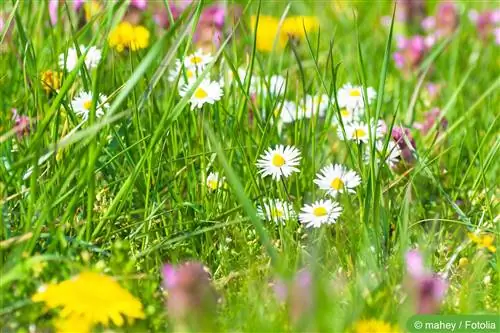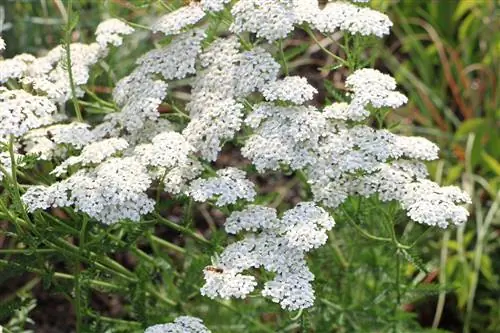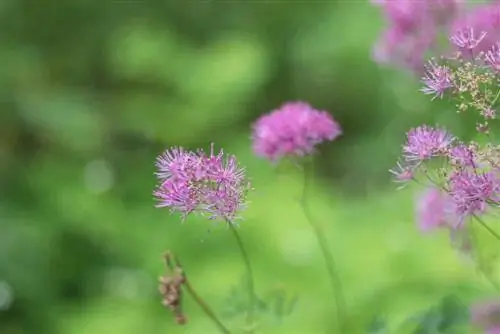- Author admin [email protected].
- Public 2023-12-17 03:39.
- Last modified 2025-06-01 06:48.
Flower meadows are characterized by their biodiversity and colorful flowers and plants. Far from over-fertilization and lawnmowers, these meadows are often the last refuge for a variety of endangered plant and animal species. The valuable biotopes are now enjoying increasing popularity among hobby gardeners. But a flower meadow is much more than just a wild lawn. It takes a lot of planning and preparation to transform your own garden into a lush, blooming landscape.
An oasis of flowers
A colorful, blooming landscape not only pleases the eye, but also offers an ideal retreat for useful insects such as bees, bumblebees, ladybirds and butterflies. All the characteristics of a well-maintained ornamental lawn fade into the background, creating a colorful and wildly thrown together oasis of plants. Flower meadows not only form a biotope for a variety of endangered animal and plant species. The hobby gardener can also sit back and relax and enjoy the wild beauty. Completely different from what is normally known from ornamental and sports lawns, a certain height of the flower meadow is actually expressly desired. The lawnmower can therefore take a longer break more often in the summer.
Depending on the nature of the soil and the respective location, a rich, wet or poor meadow can be used for the lush, flowering landscape. All three variants differ in the species diversity of the plants. Well over 60 different types of flowers, grasses and herbs often thrive in poor meadows. Fat meadows, on the other hand, are particularly characterized by a high nutrient and moisture content in the soil. Almost only moisture-loving plant species can be found in wet meadows. If you have previously had to water and fertilize frequently in summer, you should use a poor meadow. Accordingly, it is also important to prepare the soil and buy the right seeds.
Create a flower meadow
It takes very little effort to transform a garden bed or an unused garden area into a colorful oasis. If the soil is dry and poor, you should completely avoid applying fertilizer. Even humus and compost are taboo when plowing and preparing the area. The less nutrient-rich the substrate, the more plant species thrive on it. You can plant high-energy crops such as tomatoes, spinach or potatoes a year in advance. Even if the harvest yield is significantly lower: under no circumstances supply the plants with nutrients. Because the soil should be emaciated in a targeted manner.
Tip:
Many flowers, herbs and grasses prefer a high lime content in the soil. To do this, add sand or slaked lime to the substrate before sowing the plants.
The steps necessary to create a flower meadow from an ornamental lawn are an outrage in the eyes of many hobby gardeners. Because unlike fighting weeds and moss, you have to counteract the dense growth of the lawn plants yourself. To remove nutrients from the soil, follow these steps:
- Mow the grass short as often as possible.
- Avoid mulching.
- Stop fertilizing.
- Apply larger amounts of sand.
However, you will reach your goal faster if you dig up the ground over a large area. At the same time, remove the roots of the unwanted lawn plants and work sand and lime under the substrate. If you have an intensively maintained lawn, you will also achieve good results if you completely remove the top 10 cm. This is where most of the nutrients that are undesirable for a flower meadow are found.
Sowing and care
The best time to sow seed mixtures is between April and June. Before you sow the seeds, the soil should be thoroughly prepared again. This means that wilted lawn plants, moss pads and large weeds must first be removed with a rake.
- Loosen the soil sufficiently.
- Roughly remove dead lawn plants or weeds.
- Level the floor area with a rake.
Do not spread the seeds over large areas, but rather work them a few millimeters deep into the soil. Not all plants are light-germinating species, and this measure also prevents the seeds from flying away due to gusts of wind. You can find out how many seeds you need per square meter from the package leaflet. You should assume a maximum of around 10 grams. Keep the soil sufficiently moist for a few weeks.
Flower meadows are extremely sensitive and should be walked on as little as possible. This is particularly true for the time between sowing and germination. But massive damage can also occur when crossing older green spaces. For this purpose, create small paths made of gravel or stone slabs.
Several years can pass before the flower meadow shows itself in its full splendor and biodiversity. In the first few months after sowing you should mow as usual. This ensures that the roots of the perennial plants are strengthened and unwanted weeds do not have a chance to grow. Over time, pruning is reduced to a maximum of 2 to 3 times a year. Poor meadows should only be mown once a year, preferably in September. The depth of the cutting height is between 8 and 10 cm. Rake up the clippings and dispose of them in the compost.
Flower varieties
Which type of seed is suitable for flower meadows depends on the nature of the soil. Marsh marigolds, for example, only thrive in wet meadows, while wild orchids and heather carnations require a poor substrate. However, some flower varieties are extremely robust and can cope with almost any type of soil. Use native wildflower species. Because these are usually perennial and reproduce themselves through sowing and root runners.
- Fat meadows: Dandelion, cowslip, buttercup, common horn trefoil, meadow parsnip, meadow sorrel, lady's mantle, meadow bellflower, meadow sage, cranesbill, ribwort plantain, meadow knapweed, meadow chervil, bedstraw, meadow daisy
- Small meadows: White stonecrop, common yarrow, white meadow sage, cornflower, corn poppy, skullcap, blue thrush, wild orchid, ragwort, sainfoin, buck's-bellied tongue, heather carnations, pyramidal orchis, Campion, forest bird
- Wet meadows: Globeflowers, loosestrife, waterfowl, pipe grass, marsh marigolds, cabbage thistles, bloodroot, devil's bite, dyer's grosgrain, marsh pea, meadow silage
Conclusion of the editors
Flower meadows are ecologically valuable; a large number of endangered plant and animal species find an ideal habitat here. But the colorful landscape also has some advantages for hobby gardeners. For example, there is no need to regularly cut back the grass plants, and the supply of nutrients can also have a counterproductive effect. Before you can sit back and relax and watch bees, butterflies and bumblebees at work, you have to lay the foundations for your own flower meadow. Such a small biotope should not be missing in any garden. If you don't want to sacrifice your ornamental lawn for this: flower meadows are not subject to a specific size. You can also plant seeds for wildflowers and grasses in smaller, often ignored areas in the garden.
What you should know about flower meadows in brief
How do you go about creating the meadow?
Patience and therefore a lot of time are the most important requirements for being able to create a flower meadow. But correct planning is also very important and so you should first ask yourself how extensive the flower meadow should be. Should the entire garden be filled with it or just a partial area? Should children be able to run around here or is the planned flower meadow more of a feast for the eyes? - If children are involved, you should remember to plan paths in the flower meadow. This is also useful for caring for the flower meadow, as it makes it easier to get to individual plants.
- If there is a lawn at the current location for the new flower meadow, you should first stop fertilizing and only cut the lawn a few times a year.
- In autumn or early spring, the ground should be scarified vigorously. In this way you can slowly reduce the nutrient content of the soil and the first herbs typical of meadows can settle through the seeds flying from the surrounding area.
- The lawn will then be removed in some places in the spring. This is exactly where the desired flowering plants are sown or pre-grown herbs are planted.
- When sowing, you should follow the following rule of thumb: five to ten grams of seeds per square meter are completely sufficient. The seeds are just scattered on the ground and firmed with a roller.
- Watering is then important, because the future flower meadow should always be kept moist for the first four to six weeks.
- When it comes to fertilizing a flower meadow, you should know that the more species-rich the meadow is, the less fertilizer needs to be added.
Which flowers are suitable for the flower meadow?
This depends on personal taste, because you can also set up a so-called poor meadow, which is characterized by yarrow, buttercup and foamwort. But then you can't exactly talk about a colorful sea of flowers.
- Typical flowers such as carnations and scabioses are much more beautiful.
- Meadow sage also beautifies any garden.
- Other typical plant species are smooth oats, daisies and meadow clover.
- The meadow knapweed and the meadow chervil are also popular.
- Also the wild carrot and the meadow pea.
How often a flower meadow has to be mowed depends on the goal associated with creating a flower meadow. If you want the meadow to have a colorful sea next year, then it should be mowed after the seeds of grass and herbs have ripened, around September.






